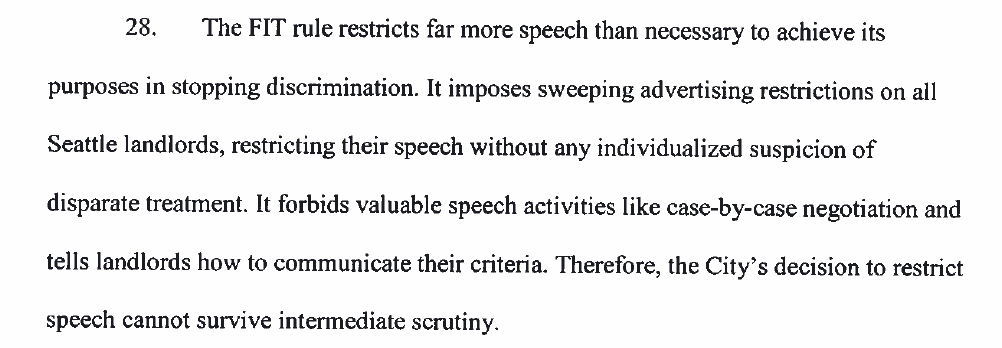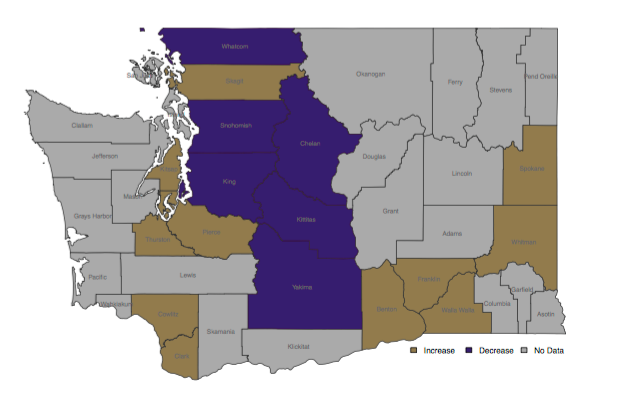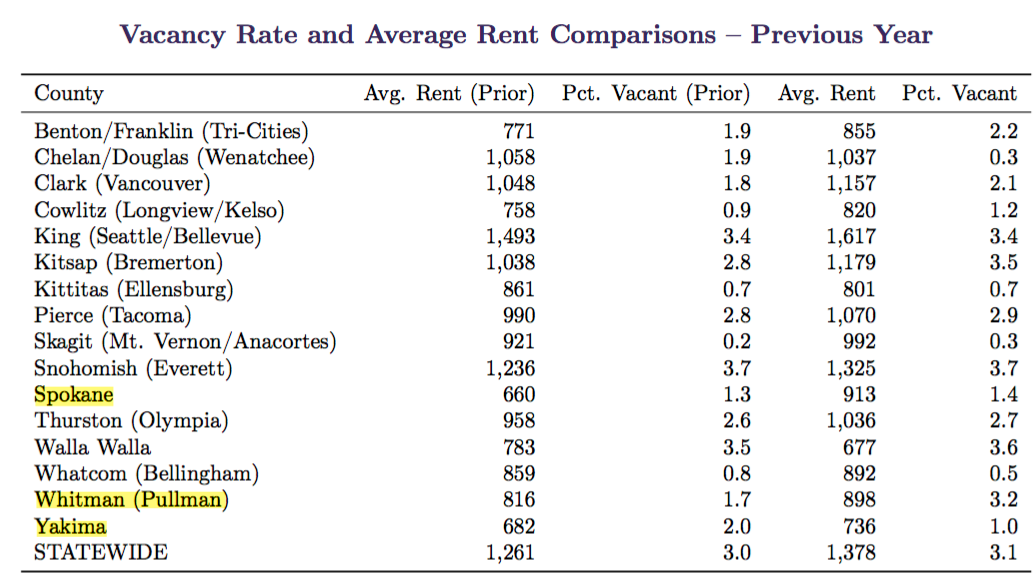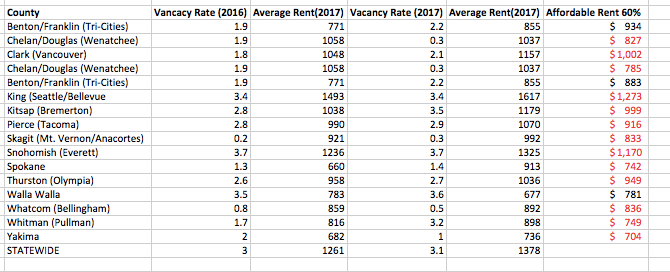First In Time Rule Overturned as Unconstitutional
We just found out late this evening that the appeal of Seattle’s First in Time rule — a requirement that a landlord rent to the first person shows up — was overturned. I haven’t had time to fully digest all the elements of the ruling but the language is very favorable. It was a breathtaking act of malpractice to pass this measure in the first place. The Council acted based on anecdote. Someone heard or saw that a landlord somewhere was offering discounts to people who worked at Amazon. The Stranger, of course, hyped the story. The Council snapped into action. Their solution: the first person who shows up gets the apartment. And of course, this solves absolutely nothing and creates a huge risk for landlords and creates paperwork and a new protected class: the first person that shows up. Not the poorest, or neediest, or the best, but the first. The Council can ignore logic and economics and The Stranger can beat its drum, but you can’t ignore the Constitution.
I pick this final piece of language in the ruling because it is so decisive. The Court acknowledges that discrimination is bad and that renting is hard for many people. But it slaps this solution down as overreaching. Among other things their “solution” is a sledgehammer, restricting speech, and “valuable speech activities like case-by-case negotiation.” Exactly. The whole idea of discretion for landlords is to give them room to mitigate risks of renting their private property. That’s the other issue: the law unconstitutionally prohibits the use of property by mandating who it can be rented to.
It is worth reading the Superior Court ruling in its entirety. I’ll be writing more about this later. But right now I am enjoying the win. Big thanks to the Rental Housing Association and the Pacific Legal Foundation who made this happen by standing up to the City Councils irresponsible behavior.
City Builder: The City Council’s Housing Policy is Like Eating Tide Pods
Over at Facebook’s City Builders page someone was not happy with my tone in the last post about Councilmember Sawant’s latest creation, a $150 million tax on jobs for housing. But Brandon Adams offered the following analogy with completely explains my tone: total frustration. I’ve made allusions to Cassandra and Laocoon (a liberal arts education is a terrible thing to waste) but I think Brandon put it in modern terms everyone can understand.
On the flip side, I like curmudgeonly Roger. It’s an attitude I understand from someone that has been working to keep Seattle from harming itself.
Imagine if your job was to keep 9 full-grown, mentally competent adults from ingesting Tide pods. Every day you go to work and you’re in a room with those 9 adults and a bowl full of Tide pods. If a majority vote to eat the Tide pods, they get to eat them, and you’ve failed at your job. You tell them why eating the Tide pods is a bad idea, you tell them they can just order some healthy food, you show them examples of people that have gone to the hospital after eating Tide pods. However, they can’t let go of the idea of eating the Tide pods. Every day at least one of them makes a comment that the Tide pods look really tasty and that we should all just try one. Sometimes they actually do vote to eat them! And then they have the audacity to tell you nothing bad happened, even though the next day they call in sick. And then the next day that you do see them, they’re still staring at that godforsaken bowl of Tide pods and licking their lips. They’ve learned nothing. You question the meaning of your life.
Now remember that outside of the analogy, every time we “eat a Tide pod” the negative impact isn’t on the council, it’s on everyone in the region. Would you be able to keep a sunny demeanor?
Image is from Use Your Brain for Science in an article called The Human Brain is the Crowing Achievement of Evolution, so Why Are People Eating Tide Pods?
I’ll Support the Jobs Tax If it Pays People’s Rent
Kshama Sawant is at it again. Later today she’ll assemble a mob demanding that the City tax Amazon and “big businesses” for $150 million per year to build affordable housing. This reveals her complete ignorance of what’s going on in housing production and weakens her credentials as a socialist. If she understood the housing market and was really a socialist, she’d demand a tax that would just redistribute corporate wealth into the bank accounts of people who are struggling to pay rent. That’s what I support.
Seattle’s Office of Housing (OH) runs one of the most desultory data operations around. I won’t even bother linking to their data — they probably wouldn’t. It’s enough to say that they’ve Googled some United States Cenus numbers and determined that there’s lots of cost burdened people in Seattle. People or households? Insert big eye roll from OH here. A lot, ok. I mean like 34,000 households or something. Are those extremely cost burdened, like they pay half their income in rent. Oh yeah!
Well the sloppily done work from OH leaves us guessing. How much money is that? In other words, are we talking about a person who earns $12,000 a year paying $500 per month in rent or a person at 50 percent of Area Medium Income (AMI) who pays $1,800 for a one bedroom? Are there 34,000 people who are paying $200 a month too much or that many paying $900 a month too much?
Why bother answering that question? That would take work, and we’re in a housing crisis after all. We need to raise more money to build housing!
One thing I know about the people at OH is they know how long it takes and how expensive it is to build housing. One has to assemble land, capital, and grind through a tedious permitting process; yes, even the design review. It might even take a decade and cost $47 million to produce just 88 units like it took Capitol Hill Housing at its flashy 12th Avenue Arts Project.
That brings us back to Councilmember Sawant, another math and fact resistant resident of City Hall. Why would she support a $150 a year tax that would go to the Office of Housing, run by a City that is run by corporatist Democrats. And why would she want all that money going to pay for housing that is subject to a bunch of rules and bureaucracy created by that system?
Why not just pay people’s rent.
Seattle spent $610,000,000 in 8 years building about 300 units of housing a year. That’s about $75 million per year. The Council and Sawant want twice that, or $150 million per year. Why stop there? The Chamber is crying in a corner, nobody listens to developers and people that actually build housing, and there hasn’t been an economist involved in the City’s housing policy ever — unless he or she was being ignored.
Let’s do this. Let’s go just a little higher, say $204 million per year. Why that much? Because that’s the equivalent of giving all those cost burdened households $500 bucks per month, per year. We already have a website set up here :http://helpmewithrent.com
Anyone could enter their data, validate with a rent receipt and pay stub, and give the City a bank account and routing number and voila! the housing crisis is over. Nobody has to build anything, apply for anything, or do any hard work. And if we’re allowed to buy a couple thousand cases of Champagne we can all celebrate the big transfer of wealth. I’ll be there. How wonderful it would be, and worth it, to stop the bad math, bad policy, bad economics, crap journalism (sorry Mike Rosenberg. I’m sure you’ll find other things skyrocketing, if you know what I mean), and endless griping.
We could go back to worrying about real problems like why do they make a single wait when there’s one spot at the noodle bar? C’mon. Sure I’m 4th in line but it’s a single spot! And sure prices on everything will go up a little bit, but wouldn’t it be worth it? Workers paradise with free shipping!
Seattle Times: “No Thanks” to Op Ed on Facts About Mandatory Inclusionary Zoning
One of my earliest memories of poetry and of libraries was finding a book of poetry by e.e. cummings called “No Thanks.” It was compelling for all the reasons cummings poetry is compelling; innovative, confusing, and full of flashes of insight. But it was also rejected by 14 publishers before cummings just published it himself calling it “No Thanks.” The following is hardly insightful unless insight is seeing what is right in front of one’s face. Someone on the Seattle Times Twitter feed saw my criticism and comment about a neighbor written op ed about the City’s Mandatory Inclusionary Zoning (MIZ) scheme called Mandatory Housing Affordability (MHA). I have more or less given up on the Times but the Twitter Times asked if I’d like to write an op ed about MHA. So I did. And I sent it in . And waited. And emailed and asked about what they thought. No response. Not even a “no thanks!” So here it is. I think the reason why the Seattle Times won’t run this is because if it is true, it would point out a glaring omission of their coverage of this issue. This is the story: non-profits, Vulcan, and the City deciding to impose MIZ on the city without consulting builders or neighborhoods. Instead, the Times and the local media report the debate over MIZ as a YIMBY versus NIMBY horse race; which side will “win?” The truth is we’re all going to lose if MHA becomes law.
In editorials, comment threads, and public meetings, the debate has started in earnest about the City of Seattle’s proposed Mandatory Housing Affordability (MHA) program, a mandate to include subsidized housing in new housing development or pay a fee. It is time to set the record straight: builders and developers who build most of the housing in the city were not party to the so called Grand Bargain that created MHA nor do they support the upzones. Here’s why.
In 2014 Councilmember Mike O’Brien proposed increases to fees for the City’s Incentive Zoning (IZ) program, a voluntary exchange of cash for additional development capacity for projects downtown and South Lake Union; developers there opposed the increases. Few developers were participating; 62 percent of eligible projects opted not to pay the fee that would subsidize non-profit built housing.
That meant fewer funds for non-profits, so the City didn’t adjust the fees lower, they doubled down, with O’Brien proposing something called a Linkage Fee, a charge on every square foot of new development in the city going forward. Again, all these funds would be collected by the City then distributed to non-profit housing developers.
Lawyers for big downtown developers threatened a lawsuit. Mayor Murray convened an aggressive locked door bargaining session between Vulcan Attorney Jack McCullough, City staff, and representatives of non-profits like Paul Lambros of Plymouth Housing, a key member of Mayor Durkan’s transition.
The result was the so called Grand Bargain, in which Vulcan and other developers downtown and in South Lake Union would pay negotiated fees on projects they had in the works, and non-profits like Lambros’ Plymouth Housing would get the fees. The rest of the city would get modest upzones and developers, not in the room, would be charged fees on every square foot of new development, much like the linkage tax.
Who was missing from this “bargain?” Neighborhood opponents are correct when they say they were not at that table. Neither were all the rest of the builders, developers, architects, nor building owners who all build and operate housing in the city. Of the eight signers of the Grand Bargain, four had interest in non-profit housing development and two worked directly for Vulcan. Not one other private developer of any size signed on to the agreement promising not to file a legal challenge to what would become the MHA program.
The reason almost every other builder and developer in town opposes the program is that it will make many of their projects infeasible because of the added costs of inclusion or pay in lieu requirement. If projects do work, it will because rents or prices will have to go up to pay the costs of the fees or lost rent for subsidized units. Finally, most legal reviews like one conducted by the Pacific Legal Foundation have found the MHA program in plain violation of state law disallowing programs that require inclusion of subsidized housing or fees in lieu – state law only allows voluntary programs.
Most builders and developers in Seattle are small local businesses and already struggle to build housing under today’s regulatory gauntlet without requirements to build subsidized housing or pay a fee. Does it make sense to boost prices of all housing to subsidize as small number of units that are cost as much as $500,000 per unit, take years to build, and have 5 year long waiting lists? Most of the development community doesn’t think so, and eventually will have to challenge MHA in court if it’s passed. The City should encourage new housing, not making it more expensive and difficult to build.
Housing Trust Fund: Vacancy Rates Down in Many Rural Areas
We’ve looked at where Housing Trust Fund resources have gone between 2008 and 2016 by population, wages, and poverty. If need for housing subsidies is defined by income and poverty levels, clearly there’s a lot of need outside Seattle and King County, maybe more need. So what about vacancy rates in rural Washington. Vacancy rates are pretty good indicator of supply and demand since they reflect apartment units that are available to meet demand. I took a look at some Dupre + Scott data for vacancy rates in the state. The report, put together by the Runstad School at the University of Washington, has a lot of helpful data. Here’s what it says.
Washington State’s apartment vacancy rate decreased from 3.3% to 3.1% in spring 2017. While there is variability among the individual county rates, all counties included in the survey had vacancy rates below 4%, including Kittitas county. The Kittitas county data is often skewed because of the difficulty in gauging occupancy of a handful of buildings that typically house students at Central Washington University. Of the rest, fourteen counties have rates below three percent indicating a shortage of rental units. Seven of the nineteen counties included in the survey had decreasing vacancy rates compared to the same time period one year ago.
I’ve pointed out before that the vacancy rate in Yakima County is about 1 percent. Here’s the data for the counties surveyed.
I highlighted the counties that had the highest poverty rates and lowest wages in my last post. Here’s a chart with some of that data and all the counties.
This includes the counties in the survey with the vacancy rates, average rents, and I’ve included the affordable rent in the far right hand column. I got that by just taking the counties Area Median Income (AMI) level at 60 percent and dividing it by the monthly rent someone could pay if they spent 30 percent of their monthly income. I highlighted in red the amounts that fall short of the average rent in 2017. You’ll note Benton and Franklin are combined as are Chelan and Douglas County.
Simply put, rural counties are experiencing very low vacancy rates and rising prices. In some cases, these rural counties have lower vacancy rates that King County. So the notion that King County has lower available housing simply isn’t true. The spread between average rent and what is affordable at 60 percent AMI is highest in King County, but the gap is present all over the state. And in some places like Chelan and Douglas the vacancy rate is lower that 1 percent. Again, King County gets the most money and has the most people, but other places in the state with needs that are just as great are getting less money.









